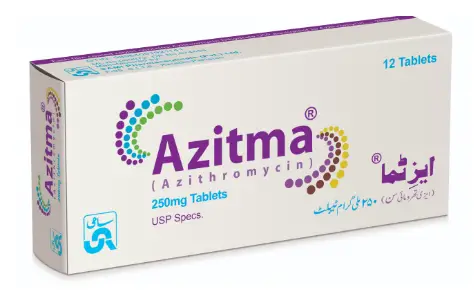Azitma (azithromycin)is a macrolide or azalide antibacterial drug for Oral administration. Macrolide are those antibacterial which contain macrocyclic lactone ring attached with deoxy sugars. The macrolides are bacteriostatic antibiotics with a broad spectrum of activity against many gram- positive bacteria.
Mechanism of Action:
Azithromycin exerts its antibacterial action by binding the 50s ribosomal subunit of susceptible organisms and thus interfering with microbial protein synthesis and inhibition of peptide translocation. Nucleic synthesis is not affected.
Absorption:
After oral administration, the bioavailability of azithromycin is approximately 37% Peak plasma level are reached after 2-3 hours.

Uses of azitma(azithromycin):
Azitma(azithromycin) is indicated for the treatment of patients with mild to moderate infections caused by susceptible strains by the designated micro-organism in the specific which are as follows..
- Acute bacterial sinusitis.
- Acute bacterial otitis media.
- Pharyngitis, tonsillitis.
- Acute exacerbation of chronic bronchitis.
- Skin and soft tissue infections.
- Uncomplicated Chlamydia trachomatis urethritis and cervicitis.
Dosage And Administration:
Adults: In uncomplicated Chlamydia trachomatis urethritis and cervicitis, the dosage is 1000mg in one single oral dose. For all other indications the dose is 1500mg, to be
administered as 500mg per day for three consecutive days. As an alternative the same total dose (1500mg) can also be administered over a period of five days with 500mg on
the first day and 250mg on the second to the fifth day.
Children: Gonococcal urethritis and cervicitis
The total dosage in children aged 1 year and older is 30mg/kg administered as 10mg/kg once daily for three days, or over a period of five days starting with a single dose of 10mg/kg on the first day, followed by doses of 5mg/kg per day for the following 4 days. There are limited data on use in children younger
than 1 year.
Side effects of azithromycin(azitma):
Adverse reactions that occurred with a frequency of 1% or less included the following:
- Genitourinary: Monilia, vaginitis and nephritis.
- Nervous System: Dizziness, headache, vertigo and somnolence.
- General: Fatigue.
- Gastrointestinal: Dyspepsia, flatulence, vomiting, melena and cholestatic jaundice.
- Cardiovascular: Palpitations and chest pain.
- Allergic: Rash, pruritus, photosensitivity and angioedema.
Contraindications:
Azithromycin is contraindicated in patients with known hypersensitivity to azithromycin or any macrolide antibiotics.
PRECAUTIONS:
As with erythromycin and other macrolides, rare serious allergic reactions, including angioedema and anaphylaxis (rarely fatal), have been reported. Some of these reactions
with azithromycin have resulted in recurrent symptoms and required a longer period of observation and treatment.
Since liver is the principal route of elimination for azithromycin, the use of azithromycin should be undertaken with caution in patients with significant hepatic disease, Cases of
fulminant hepatitis potentially leading to life-threatening liver failure have been reported with azithromycin. Some patients may have had pre-existing hepatic disease or may
have been taking other hepatotoxic medicinal products
In case of signs and symptoms of liver dysfunction, such as rapid developing asthenia associated with jaundice, dark urine, bleeding tendency or hepatic encephalopathy, liver
function tests/investigations should be performed immediately. Azithromycin administration should be stopped if liver dysfunction has emerged.
DRUG INTERACTIONS:
Antacids: In patients receiving both azithromycin and antacids, the drugs should not be taken simultaneously. Azithromycin should be taken at least 1 hour before or 2 hours
after the antacid.
Cyclosporine: Caution should be exercised before considering concurrent administration of these drugs. If co-administration of these drugs is necessary, cyclosporine levels
should be monitored and the dose should be adjusted accordingly.
Theophylline: Theophylline levels may be increased in patients taking azithromycin
Coumarin-type oral anticoagulants: Consideration should be given ta the frequency of monitoring prothrombin time, when azithromycin is used in patients receiving
coumarin-type oral anti-coagulants
Digoxin: In patients receiving concomitant azithromycin, a related azalide antibiotic, and digoxin, the possibility of raised digoxin levels should be in mind.
OVERDOSE:
Adverse events experienced in higher than recommended doses were similar to those seen at normal doses. The typical symptoms of an overdose with macrolide antibiotics
include severe nausea, vomiting and diarrhea. In the event of overdosage, general symptomatic and supportive measures are indicated as required.
AVAILIBILITY:
- 250mg Tablets in a pack of 12s.
- 500mg tablets in a pack of 6s.
- 200mg/5ml suspension in a pack of 15ml.
- 200mg/5ml suspension in a pack of 30ml.
INSTRUCTIONS:
- Keep out of reach of children.
- Avoid exposure to heat, light and humidity
- Store between 15 to 30 C
- improper storage may deteriorate the medicine.
BUY NOW
Disclaimer
The information provided on this platform is for general informational purposes only and is not intended as a substitute for professional medical advice, diagnosis, or treatment. Always seek the advice of your physician or other qualified health providers with any questions you may have regarding a medical condition. Never disregard professional medical advice or delay in seeking it because of something you have read on this platform.